Analyzing Greenhouse Gas Emission Reduction in Water Utilities
VerifiedAdded on 2023/06/11
|5
|1544
|223
Report
AI Summary
This report delves into the strategies employed by water utilities, specifically Tampa Bay Water, to reduce greenhouse gas (GHG) emissions. It highlights the significance of water quality and efficient water usage in minimizing GHG production, particularly by reducing energy consumption in pumping and treatment processes. The report details Tampa Bay Water's Energy Management System (EnMS) and its reliance on data from the Energy Consumption Manager and EPA to estimate GHG emissions. It explains the methodology used to quantify emissions based on water demand and electricity usage, emphasizing the conversion of EPA data into pounds and megawatt-hours into kWh to calculate emission rates. Furthermore, the report explores methods for identifying emission factors, including estimations from power generating companies and electric grid selection, highlighting the importance of accurate, localized data for effective GHG emission reduction strategies. The document references key sources, including EPA data and academic research, to support its analysis.
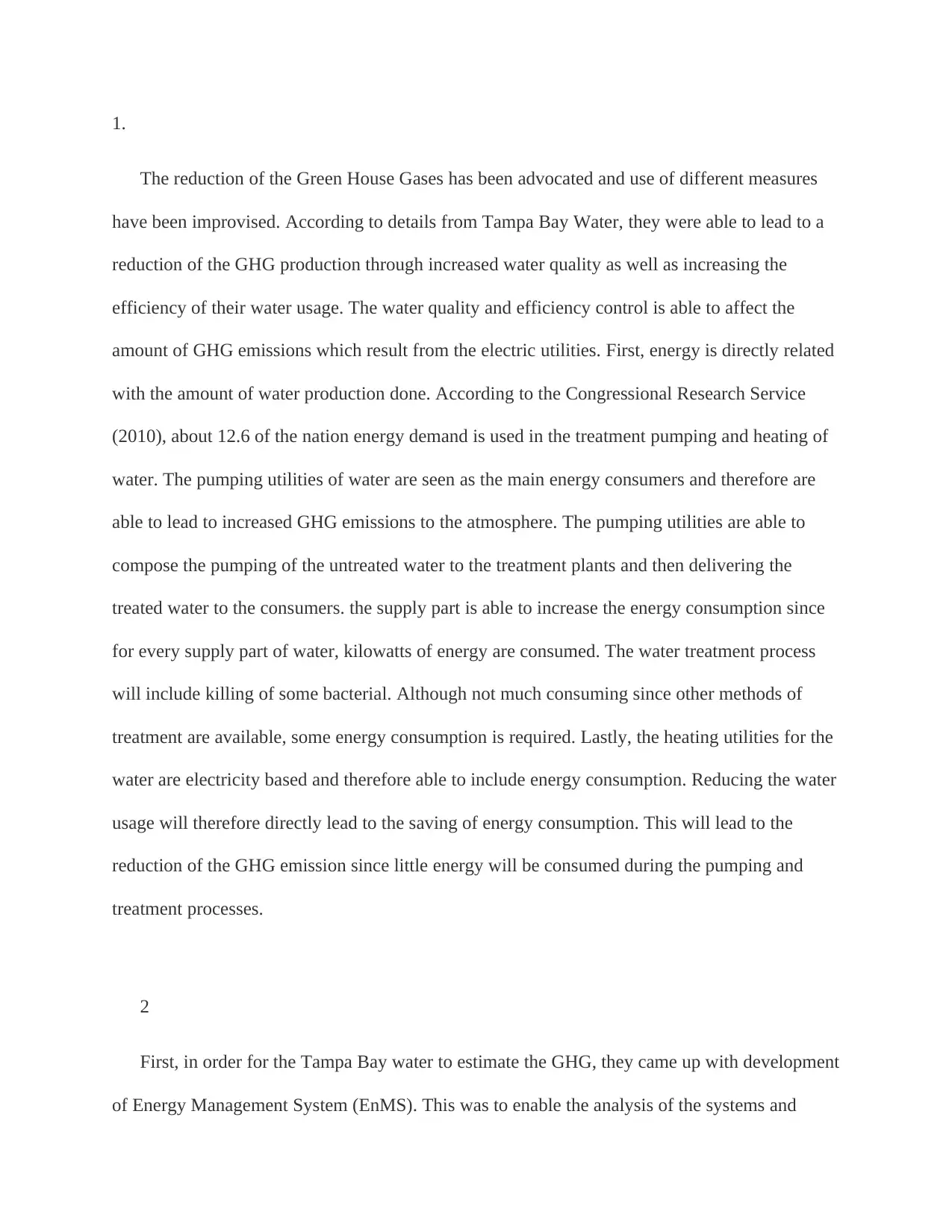
1.
The reduction of the Green House Gases has been advocated and use of different measures
have been improvised. According to details from Tampa Bay Water, they were able to lead to a
reduction of the GHG production through increased water quality as well as increasing the
efficiency of their water usage. The water quality and efficiency control is able to affect the
amount of GHG emissions which result from the electric utilities. First, energy is directly related
with the amount of water production done. According to the Congressional Research Service
(2010), about 12.6 of the nation energy demand is used in the treatment pumping and heating of
water. The pumping utilities of water are seen as the main energy consumers and therefore are
able to lead to increased GHG emissions to the atmosphere. The pumping utilities are able to
compose the pumping of the untreated water to the treatment plants and then delivering the
treated water to the consumers. the supply part is able to increase the energy consumption since
for every supply part of water, kilowatts of energy are consumed. The water treatment process
will include killing of some bacterial. Although not much consuming since other methods of
treatment are available, some energy consumption is required. Lastly, the heating utilities for the
water are electricity based and therefore able to include energy consumption. Reducing the water
usage will therefore directly lead to the saving of energy consumption. This will lead to the
reduction of the GHG emission since little energy will be consumed during the pumping and
treatment processes.
2
First, in order for the Tampa Bay water to estimate the GHG, they came up with development
of Energy Management System (EnMS). This was to enable the analysis of the systems and
The reduction of the Green House Gases has been advocated and use of different measures
have been improvised. According to details from Tampa Bay Water, they were able to lead to a
reduction of the GHG production through increased water quality as well as increasing the
efficiency of their water usage. The water quality and efficiency control is able to affect the
amount of GHG emissions which result from the electric utilities. First, energy is directly related
with the amount of water production done. According to the Congressional Research Service
(2010), about 12.6 of the nation energy demand is used in the treatment pumping and heating of
water. The pumping utilities of water are seen as the main energy consumers and therefore are
able to lead to increased GHG emissions to the atmosphere. The pumping utilities are able to
compose the pumping of the untreated water to the treatment plants and then delivering the
treated water to the consumers. the supply part is able to increase the energy consumption since
for every supply part of water, kilowatts of energy are consumed. The water treatment process
will include killing of some bacterial. Although not much consuming since other methods of
treatment are available, some energy consumption is required. Lastly, the heating utilities for the
water are electricity based and therefore able to include energy consumption. Reducing the water
usage will therefore directly lead to the saving of energy consumption. This will lead to the
reduction of the GHG emission since little energy will be consumed during the pumping and
treatment processes.
2
First, in order for the Tampa Bay water to estimate the GHG, they came up with development
of Energy Management System (EnMS). This was to enable the analysis of the systems and
Paraphrase This Document
Need a fresh take? Get an instant paraphrase of this document with our AI Paraphraser
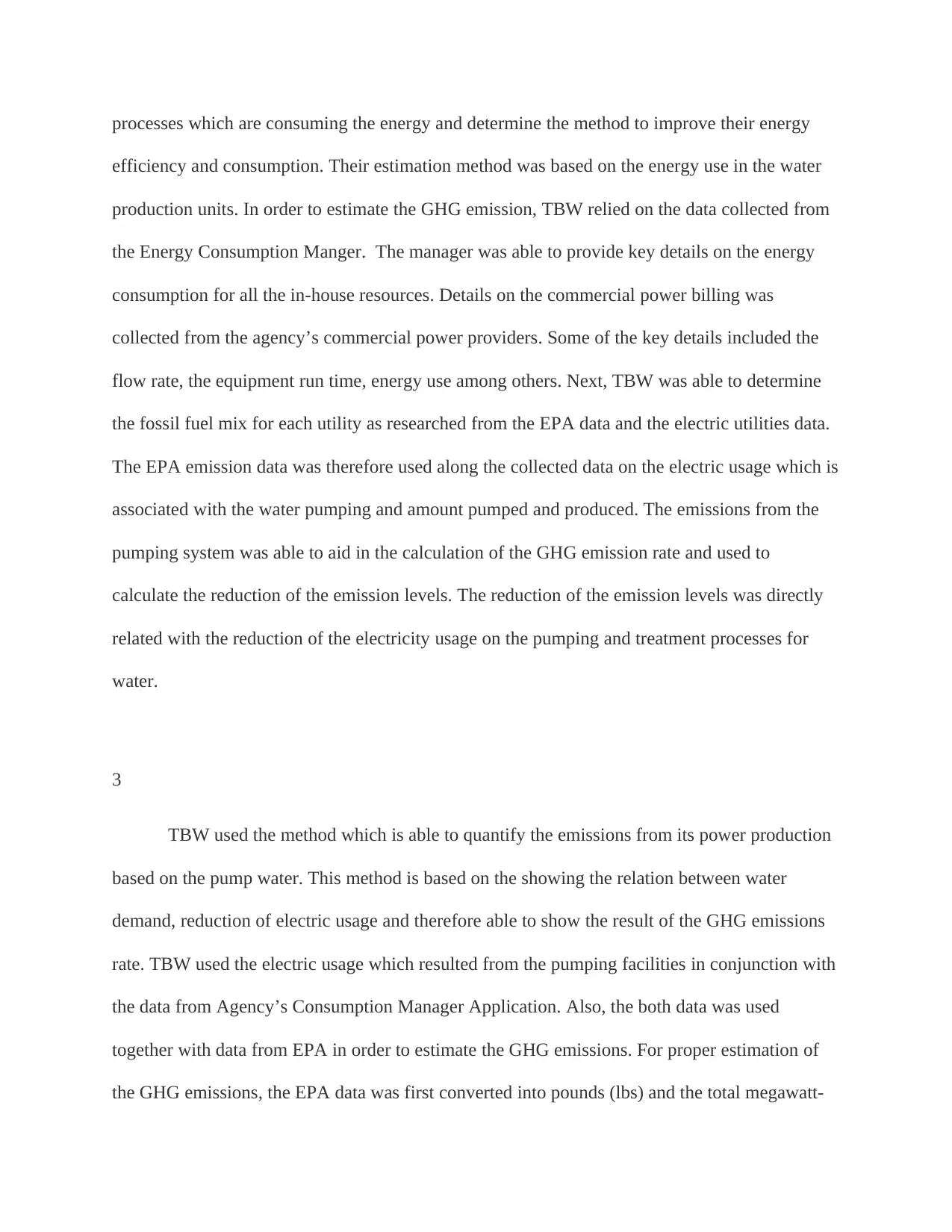
processes which are consuming the energy and determine the method to improve their energy
efficiency and consumption. Their estimation method was based on the energy use in the water
production units. In order to estimate the GHG emission, TBW relied on the data collected from
the Energy Consumption Manger. The manager was able to provide key details on the energy
consumption for all the in-house resources. Details on the commercial power billing was
collected from the agency’s commercial power providers. Some of the key details included the
flow rate, the equipment run time, energy use among others. Next, TBW was able to determine
the fossil fuel mix for each utility as researched from the EPA data and the electric utilities data.
The EPA emission data was therefore used along the collected data on the electric usage which is
associated with the water pumping and amount pumped and produced. The emissions from the
pumping system was able to aid in the calculation of the GHG emission rate and used to
calculate the reduction of the emission levels. The reduction of the emission levels was directly
related with the reduction of the electricity usage on the pumping and treatment processes for
water.
3
TBW used the method which is able to quantify the emissions from its power production
based on the pump water. This method is based on the showing the relation between water
demand, reduction of electric usage and therefore able to show the result of the GHG emissions
rate. TBW used the electric usage which resulted from the pumping facilities in conjunction with
the data from Agency’s Consumption Manager Application. Also, the both data was used
together with data from EPA in order to estimate the GHG emissions. For proper estimation of
the GHG emissions, the EPA data was first converted into pounds (lbs) and the total megawatt-
efficiency and consumption. Their estimation method was based on the energy use in the water
production units. In order to estimate the GHG emission, TBW relied on the data collected from
the Energy Consumption Manger. The manager was able to provide key details on the energy
consumption for all the in-house resources. Details on the commercial power billing was
collected from the agency’s commercial power providers. Some of the key details included the
flow rate, the equipment run time, energy use among others. Next, TBW was able to determine
the fossil fuel mix for each utility as researched from the EPA data and the electric utilities data.
The EPA emission data was therefore used along the collected data on the electric usage which is
associated with the water pumping and amount pumped and produced. The emissions from the
pumping system was able to aid in the calculation of the GHG emission rate and used to
calculate the reduction of the emission levels. The reduction of the emission levels was directly
related with the reduction of the electricity usage on the pumping and treatment processes for
water.
3
TBW used the method which is able to quantify the emissions from its power production
based on the pump water. This method is based on the showing the relation between water
demand, reduction of electric usage and therefore able to show the result of the GHG emissions
rate. TBW used the electric usage which resulted from the pumping facilities in conjunction with
the data from Agency’s Consumption Manager Application. Also, the both data was used
together with data from EPA in order to estimate the GHG emissions. For proper estimation of
the GHG emissions, the EPA data was first converted into pounds (lbs) and the total megawatt-
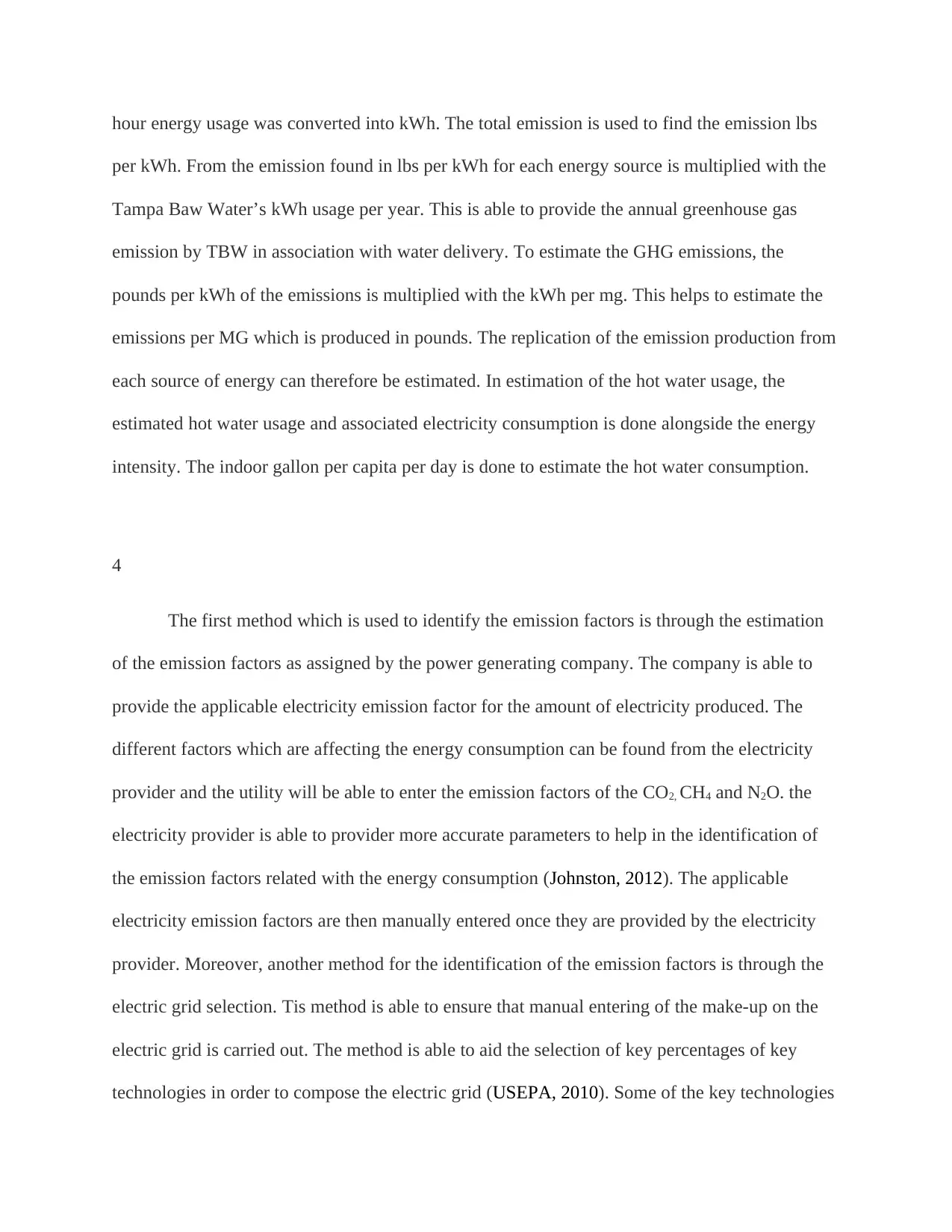
hour energy usage was converted into kWh. The total emission is used to find the emission lbs
per kWh. From the emission found in lbs per kWh for each energy source is multiplied with the
Tampa Baw Water’s kWh usage per year. This is able to provide the annual greenhouse gas
emission by TBW in association with water delivery. To estimate the GHG emissions, the
pounds per kWh of the emissions is multiplied with the kWh per mg. This helps to estimate the
emissions per MG which is produced in pounds. The replication of the emission production from
each source of energy can therefore be estimated. In estimation of the hot water usage, the
estimated hot water usage and associated electricity consumption is done alongside the energy
intensity. The indoor gallon per capita per day is done to estimate the hot water consumption.
4
The first method which is used to identify the emission factors is through the estimation
of the emission factors as assigned by the power generating company. The company is able to
provide the applicable electricity emission factor for the amount of electricity produced. The
different factors which are affecting the energy consumption can be found from the electricity
provider and the utility will be able to enter the emission factors of the CO2, CH4 and N2O. the
electricity provider is able to provider more accurate parameters to help in the identification of
the emission factors related with the energy consumption (Johnston, 2012). The applicable
electricity emission factors are then manually entered once they are provided by the electricity
provider. Moreover, another method for the identification of the emission factors is through the
electric grid selection. Tis method is able to ensure that manual entering of the make-up on the
electric grid is carried out. The method is able to aid the selection of key percentages of key
technologies in order to compose the electric grid (USEPA, 2010). Some of the key technologies
per kWh. From the emission found in lbs per kWh for each energy source is multiplied with the
Tampa Baw Water’s kWh usage per year. This is able to provide the annual greenhouse gas
emission by TBW in association with water delivery. To estimate the GHG emissions, the
pounds per kWh of the emissions is multiplied with the kWh per mg. This helps to estimate the
emissions per MG which is produced in pounds. The replication of the emission production from
each source of energy can therefore be estimated. In estimation of the hot water usage, the
estimated hot water usage and associated electricity consumption is done alongside the energy
intensity. The indoor gallon per capita per day is done to estimate the hot water consumption.
4
The first method which is used to identify the emission factors is through the estimation
of the emission factors as assigned by the power generating company. The company is able to
provide the applicable electricity emission factor for the amount of electricity produced. The
different factors which are affecting the energy consumption can be found from the electricity
provider and the utility will be able to enter the emission factors of the CO2, CH4 and N2O. the
electricity provider is able to provider more accurate parameters to help in the identification of
the emission factors related with the energy consumption (Johnston, 2012). The applicable
electricity emission factors are then manually entered once they are provided by the electricity
provider. Moreover, another method for the identification of the emission factors is through the
electric grid selection. Tis method is able to ensure that manual entering of the make-up on the
electric grid is carried out. The method is able to aid the selection of key percentages of key
technologies in order to compose the electric grid (USEPA, 2010). Some of the key technologies
⊘ This is a preview!⊘
Do you want full access?
Subscribe today to unlock all pages.

Trusted by 1+ million students worldwide
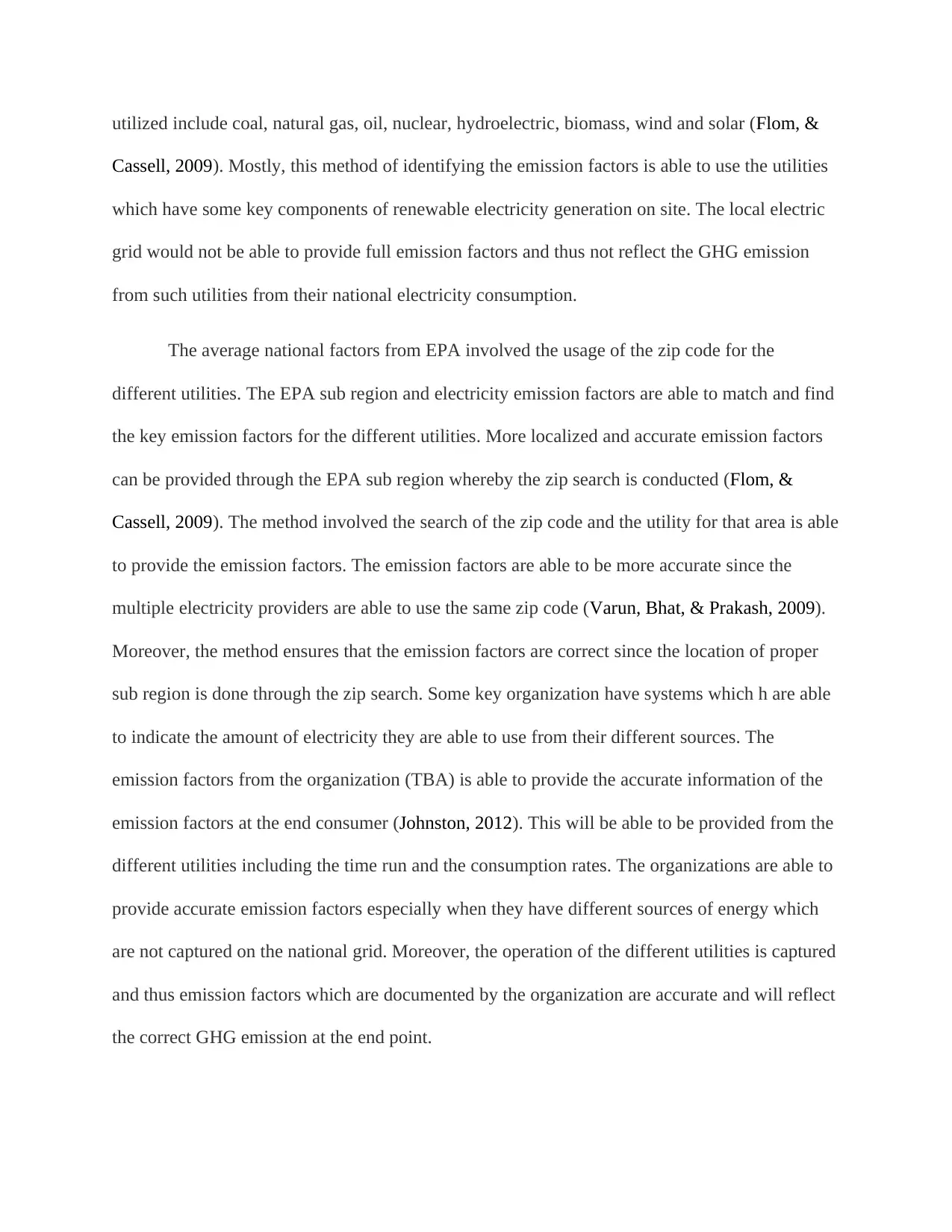
utilized include coal, natural gas, oil, nuclear, hydroelectric, biomass, wind and solar (Flom, &
Cassell, 2009). Mostly, this method of identifying the emission factors is able to use the utilities
which have some key components of renewable electricity generation on site. The local electric
grid would not be able to provide full emission factors and thus not reflect the GHG emission
from such utilities from their national electricity consumption.
The average national factors from EPA involved the usage of the zip code for the
different utilities. The EPA sub region and electricity emission factors are able to match and find
the key emission factors for the different utilities. More localized and accurate emission factors
can be provided through the EPA sub region whereby the zip search is conducted (Flom, &
Cassell, 2009). The method involved the search of the zip code and the utility for that area is able
to provide the emission factors. The emission factors are able to be more accurate since the
multiple electricity providers are able to use the same zip code (Varun, Bhat, & Prakash, 2009).
Moreover, the method ensures that the emission factors are correct since the location of proper
sub region is done through the zip search. Some key organization have systems which h are able
to indicate the amount of electricity they are able to use from their different sources. The
emission factors from the organization (TBA) is able to provide the accurate information of the
emission factors at the end consumer (Johnston, 2012). This will be able to be provided from the
different utilities including the time run and the consumption rates. The organizations are able to
provide accurate emission factors especially when they have different sources of energy which
are not captured on the national grid. Moreover, the operation of the different utilities is captured
and thus emission factors which are documented by the organization are accurate and will reflect
the correct GHG emission at the end point.
Cassell, 2009). Mostly, this method of identifying the emission factors is able to use the utilities
which have some key components of renewable electricity generation on site. The local electric
grid would not be able to provide full emission factors and thus not reflect the GHG emission
from such utilities from their national electricity consumption.
The average national factors from EPA involved the usage of the zip code for the
different utilities. The EPA sub region and electricity emission factors are able to match and find
the key emission factors for the different utilities. More localized and accurate emission factors
can be provided through the EPA sub region whereby the zip search is conducted (Flom, &
Cassell, 2009). The method involved the search of the zip code and the utility for that area is able
to provide the emission factors. The emission factors are able to be more accurate since the
multiple electricity providers are able to use the same zip code (Varun, Bhat, & Prakash, 2009).
Moreover, the method ensures that the emission factors are correct since the location of proper
sub region is done through the zip search. Some key organization have systems which h are able
to indicate the amount of electricity they are able to use from their different sources. The
emission factors from the organization (TBA) is able to provide the accurate information of the
emission factors at the end consumer (Johnston, 2012). This will be able to be provided from the
different utilities including the time run and the consumption rates. The organizations are able to
provide accurate emission factors especially when they have different sources of energy which
are not captured on the national grid. Moreover, the operation of the different utilities is captured
and thus emission factors which are documented by the organization are accurate and will reflect
the correct GHG emission at the end point.
Paraphrase This Document
Need a fresh take? Get an instant paraphrase of this document with our AI Paraphraser
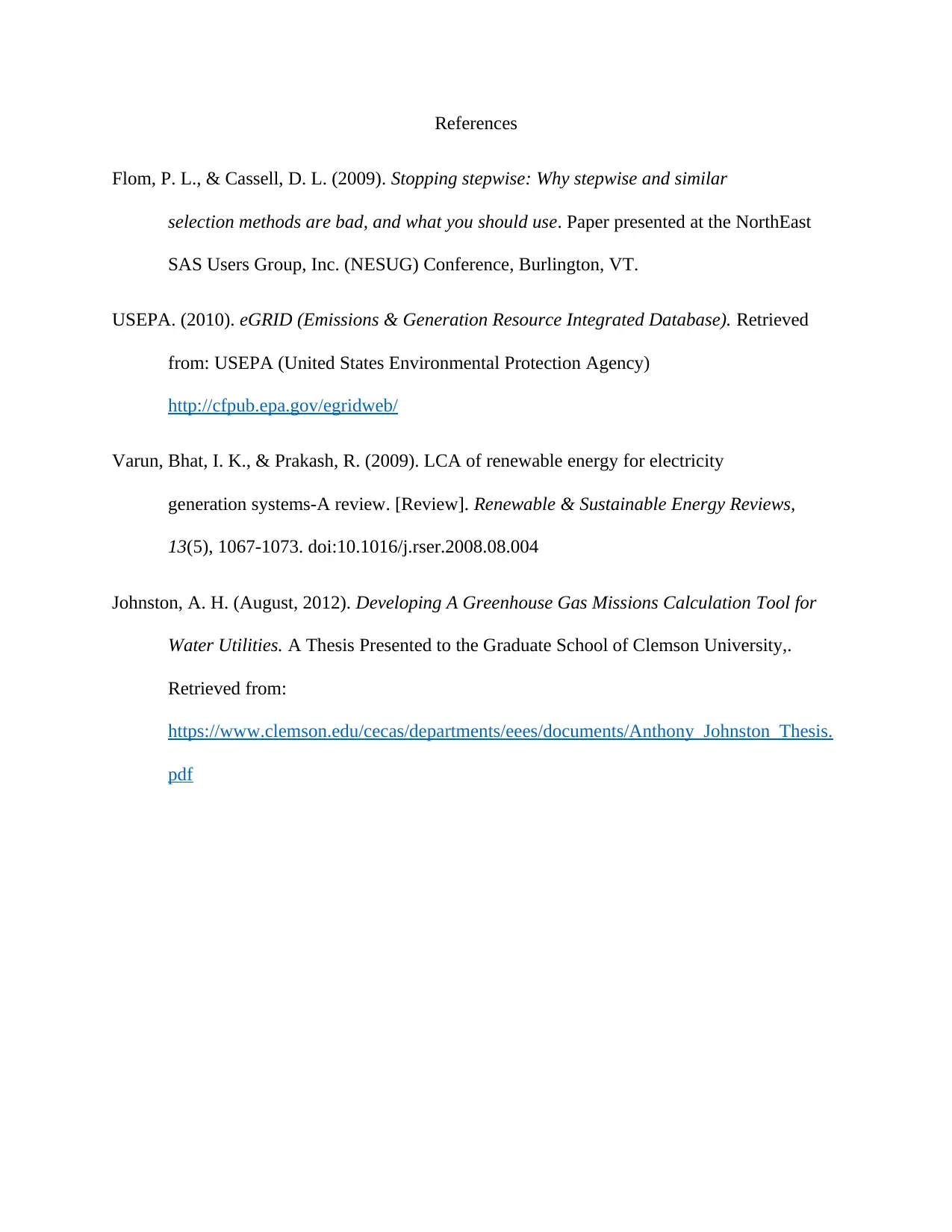
References
Flom, P. L., & Cassell, D. L. (2009). Stopping stepwise: Why stepwise and similar
selection methods are bad, and what you should use. Paper presented at the NorthEast
SAS Users Group, Inc. (NESUG) Conference, Burlington, VT.
USEPA. (2010). eGRID (Emissions & Generation Resource Integrated Database). Retrieved
from: USEPA (United States Environmental Protection Agency)
http://cfpub.epa.gov/egridweb/
Varun, Bhat, I. K., & Prakash, R. (2009). LCA of renewable energy for electricity
generation systems-A review. [Review]. Renewable & Sustainable Energy Reviews,
13(5), 1067-1073. doi:10.1016/j.rser.2008.08.004
Johnston, A. H. (August, 2012). Developing A Greenhouse Gas Missions Calculation Tool for
Water Utilities. A Thesis Presented to the Graduate School of Clemson University,.
Retrieved from:
https://www.clemson.edu/cecas/departments/eees/documents/Anthony_Johnston_Thesis.
pdf
Flom, P. L., & Cassell, D. L. (2009). Stopping stepwise: Why stepwise and similar
selection methods are bad, and what you should use. Paper presented at the NorthEast
SAS Users Group, Inc. (NESUG) Conference, Burlington, VT.
USEPA. (2010). eGRID (Emissions & Generation Resource Integrated Database). Retrieved
from: USEPA (United States Environmental Protection Agency)
http://cfpub.epa.gov/egridweb/
Varun, Bhat, I. K., & Prakash, R. (2009). LCA of renewable energy for electricity
generation systems-A review. [Review]. Renewable & Sustainable Energy Reviews,
13(5), 1067-1073. doi:10.1016/j.rser.2008.08.004
Johnston, A. H. (August, 2012). Developing A Greenhouse Gas Missions Calculation Tool for
Water Utilities. A Thesis Presented to the Graduate School of Clemson University,.
Retrieved from:
https://www.clemson.edu/cecas/departments/eees/documents/Anthony_Johnston_Thesis.
1 out of 5
Related Documents
Your All-in-One AI-Powered Toolkit for Academic Success.
+13062052269
info@desklib.com
Available 24*7 on WhatsApp / Email
![[object Object]](/_next/static/media/star-bottom.7253800d.svg)
Unlock your academic potential
Copyright © 2020–2025 A2Z Services. All Rights Reserved. Developed and managed by ZUCOL.




